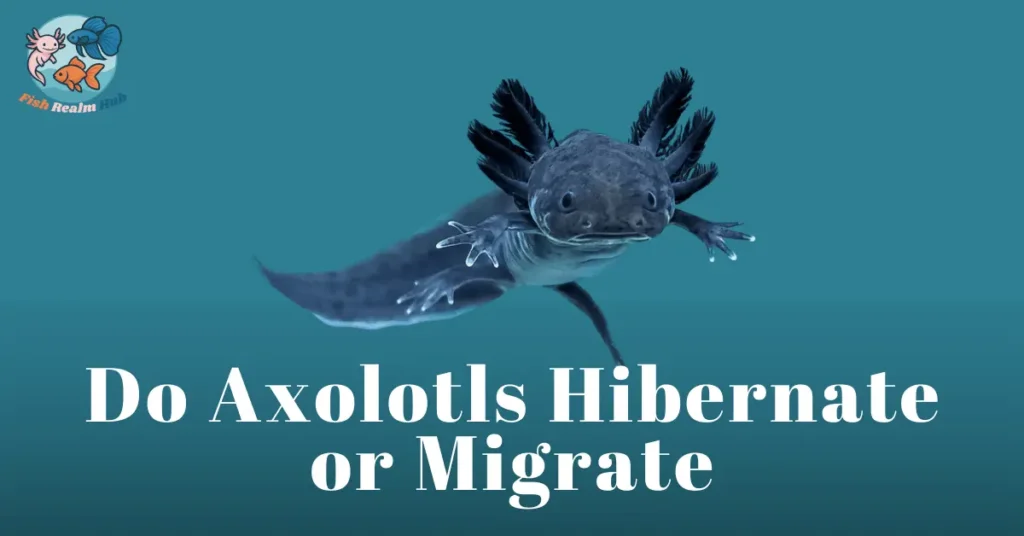When I first became interested in Axolotl, I wondered if they hibernated or migrated like some other animals. But after learning more, I discovered that they don’t either. Axolotl stays in one place and slow down a bit when they get cold.

Do Axolotls Hibernate or Migrate ?
When I first saw Axolotl move less during the winter, I thought they were probably hibernating like some. But then I read that Axolotl do not really hibernate – they slow down when the water cools. This is called the state of low activity, not true hibernation.
I didn’t change the tank too often, just made sure that the temperature was not too low. After that, the Axolotl began to work as usual again. So far I know that they do not sleep all winter – they just need constant and cold water to be happy.
At first, I thought Axolotl could migrate like birds or fish that swim to warmer places, but it turns out they don’t. Axolotl stays in one place and doesn’t move around much, even when the water cools. In the wild, they live in a lake or canal their entire lives. They don’t travel far with the weather or change homes. I’ve found that as long as their tank feels safe and the water is clean, they’re happy to stay put.
What Hibernation Means
I used to imagine hibernation as if only animals are going to sleep for the winter, but it’s much more than that. This is when their entire body slows down – less breathing, slower heartbeats, and hardly any movement. I found out that axolotls don’t really do that. Even when it cools down, they don’t stop completely like some animals.
They may move less, but they stay awake. That’s why I always make sure my tank stays at a stable, cool temperature, so my axolotl is comfortable and not too slow.
Natural Water Temperature and Seasonal Changes
When I learned where axolotls come from, I was surprised to know their lakes stay cool most of the year—not too cold or hot. Since the water there doesn’t change much with the seasons, axolotls don’t need to hibernate or move around.
They’re used to steady temperatures, so big changes can stress them out. That’s why I try to keep my axolotl tank between 16 and 18 degrees Celsius (60 to 64 degrees Fahrenheit), just like in the wild. It helps them stay calm, active, and healthy all year.
How Their Body Slows Down in Cold Water
One winter, I noticed my axolotl wasn’t moving much and just stayed in one corner of the tank. I got really worried at first. But after reading a bit, I found out that when the water gets cold, axolotls slow down—it’s not real sleep like hibernation, just a quiet, low-energy state.
They move less, eat less, and seem super calm. It’s usually okay as long as the water isn’t too cold, but I still checked the temperature. After warming it up a little, my axolotl started acting normal again. Now I always keep an eye on the tank’s temperature in winter to stop this slow-down from happening.
Do Axolotls Migrate in Their Natural Habitat?
I used to think axolotls might travel to new places when seasons change, like some animals do. But after learning more, I found out that they don’t really migrate. In the wild, they live in cool lakes that stay about the same all year, so they don’t need to move.
Their home doesn’t freeze or get too hot, so they just stay where they are. That’s why I try to keep my axolotl’s tank steady too. If the water stays cool and clean, they’re happy and don’t need to go anywhere.
How to keep them stable all year in home aquariums
To keep my axolotl healthy all year, I try to make the tank feel like its natural home. I don’t let the water get too hot or too cold. I use a thermometer to check the temperature often, especially in summer and winter.
I also avoid loud noises or bright lights near the tank, because that can stress them out. When the water stays cool and clean, my axolotl stays calm and active. It doesn’t need to hibernate or move around—it just needs a quiet and steady place to live.
Conclusion
After everything I’ve learned and seen with my own axolotl, I can say they don’t need to hibernate or migrate like other animals. They just need the right water temperature and a calm space to stay happy. If you keep their tank cool, clean, and steady, they’ll stay active and healthy all year round—no moving or deep sleep needed.
Faqs
Do axolotls migrate or hibernate?
Some people think axolotls might migrate or hibernate like other cold-blooded animals, but they don’t. These amazing creatures stay in water their whole lives and keep their gilled form, which means they never go through metamorphosis to live on land like other salamanders. I used to believe they hibernate in winter, but I found out they just enter a quiet time of reduced activity, not full hibernation or brumation. Since they are fully aquatic, they simply slow down when it gets cold instead of traveling or sleeping for months.
What do axolotls do in the winter?
During winter, I noticed my axolotls get a little slower, but they don’t hide underground like mole salamanders or Tiger salamanders do in North America. Those salamanders escape the cold by staying in animal burrows or deep crevices to avoid freezing temperature, but axolotls don’t need to. Since they live in water that stays cool but not frozen, they just stay put and move less when it’s cold.
What is the lifespan of an axolotl?
People often ask how long axolotls can live, especially if you’re thinking about keeping one at home. In the wild, they generally survive about 5 to 6 years, but in captivity, they can reach up to 15 years with the right care. I’ve noticed that when their tank setup is stable and quiet, they stay more active and look healthier.
One interesting thing about them is how early they grow up—axolotls usually reach reproductive maturity in their first year of life. I remember being surprised when mine started showing breeding behavior not long after I brought them home. Knowing the lifespan and breeding cycle helps a lot in giving them what they need.
Why do axolotls turn into salamanders?
It’s pretty wild, but axolotls sometimes change in rare cases and undergo a process called metamorphosis, where they turn into terrestrial salamanders. Even though they’re supposed to stay in their neotenic form, which means they retain their juvenile and larval features throughout their adult lives, certain external factors like hormonal manipulation or exposure to strong environmental conditions can cause this shift.
It’s not common, but I’ve seen photos of axolotls that were induced to change, and they looked just like other amphibians that live on land. What surprised me most was that they could still reproduce after transforming, even though most stay water-based.

